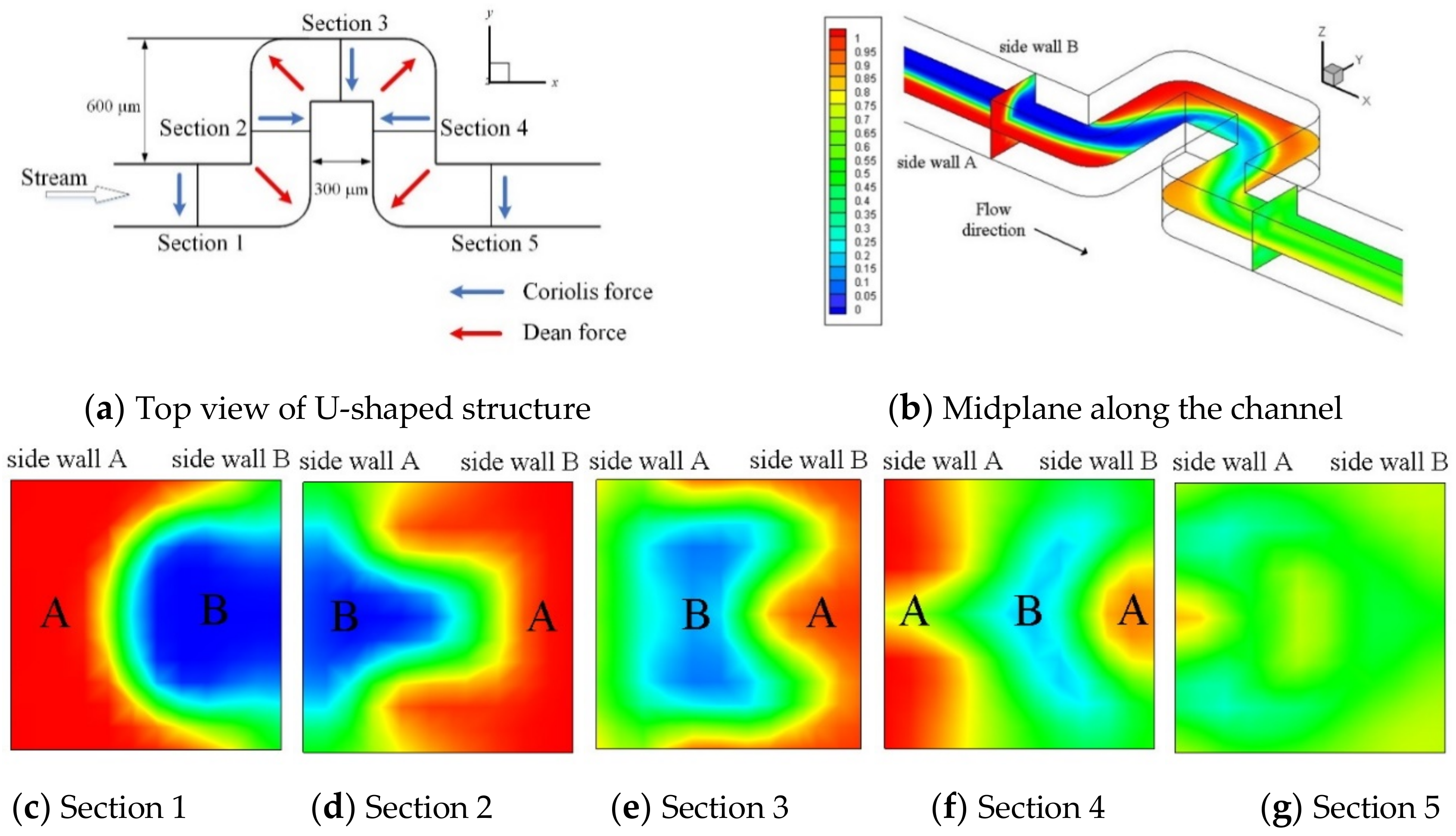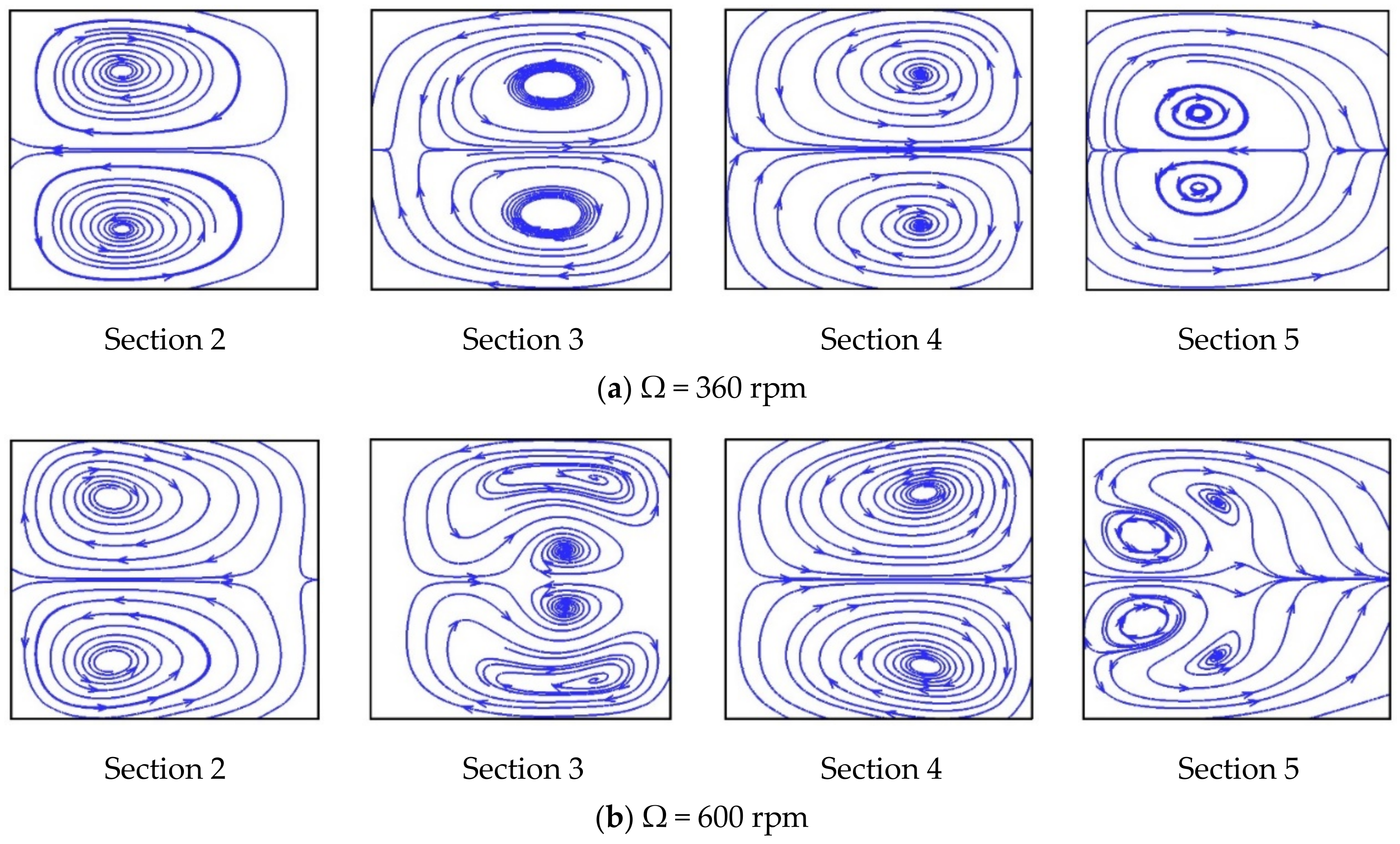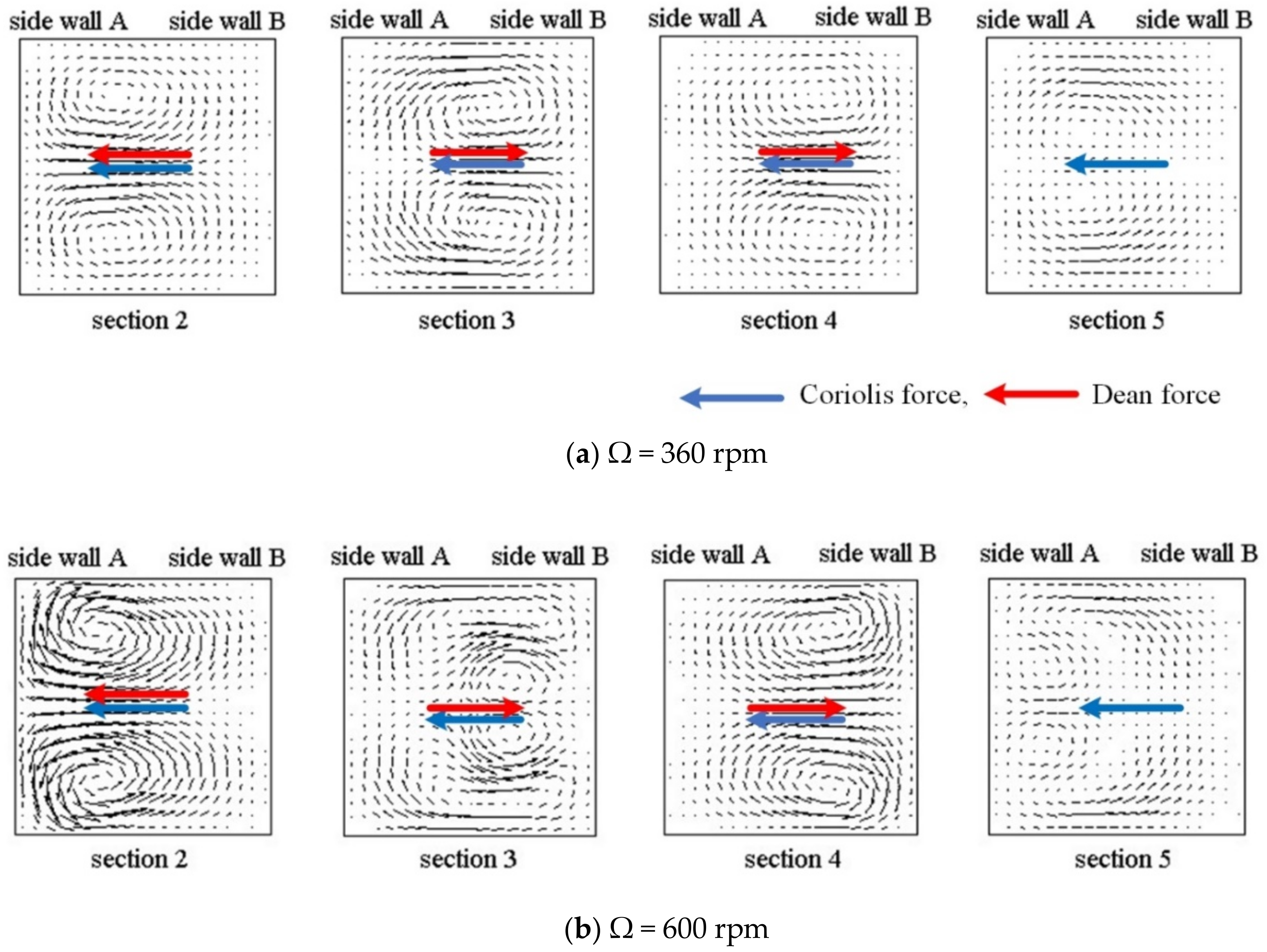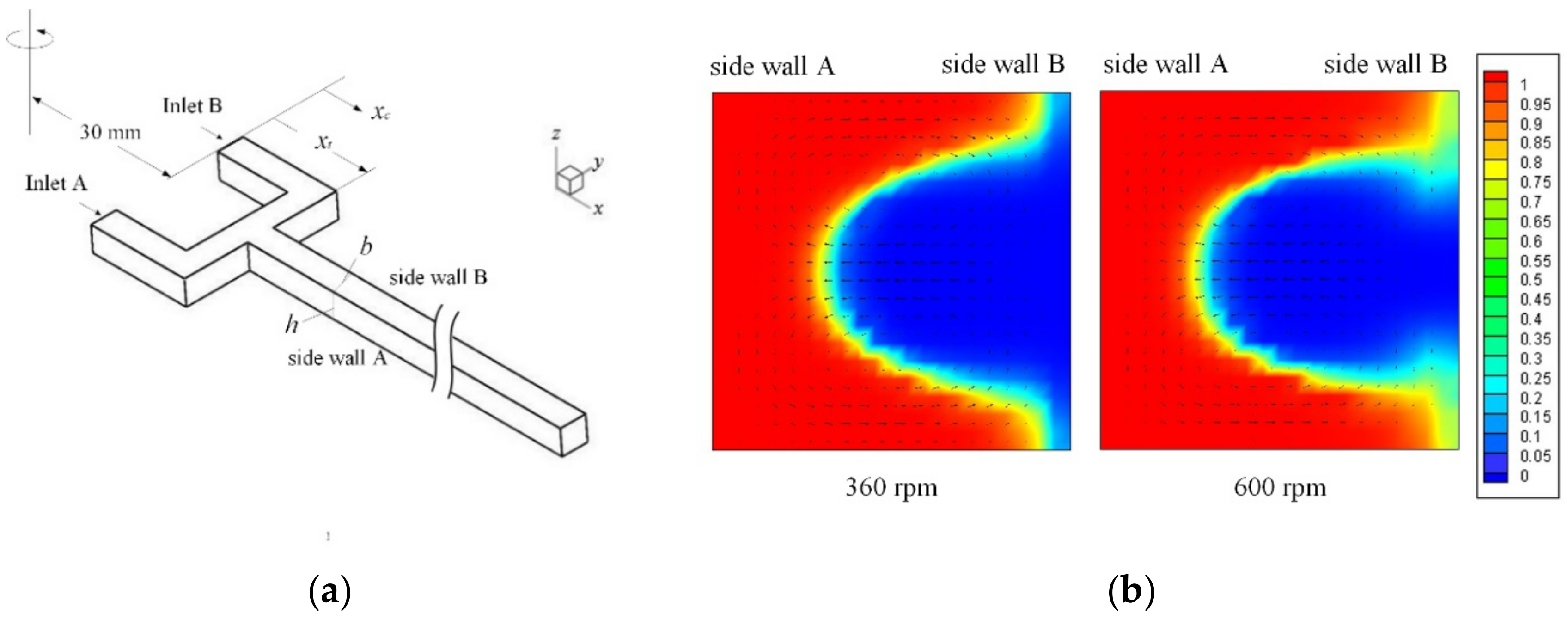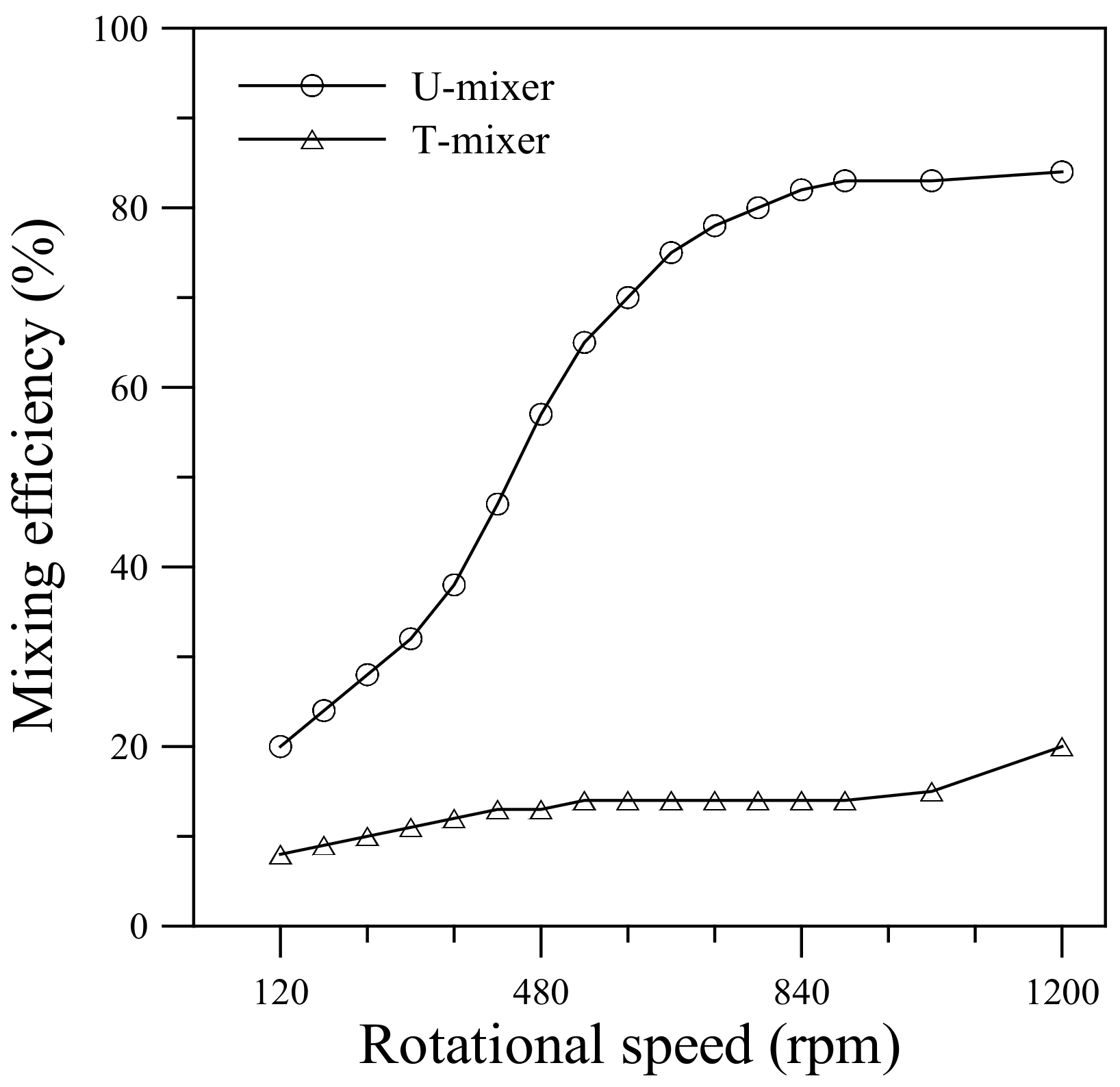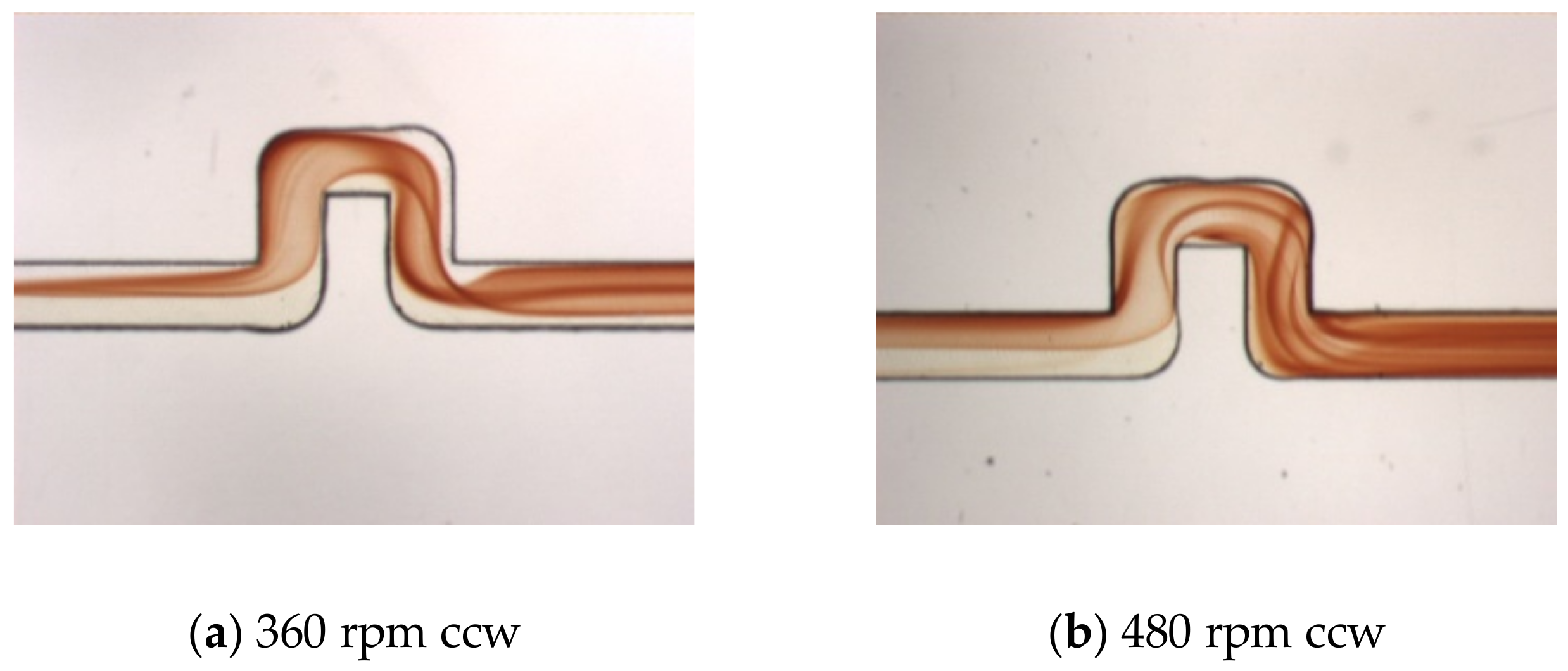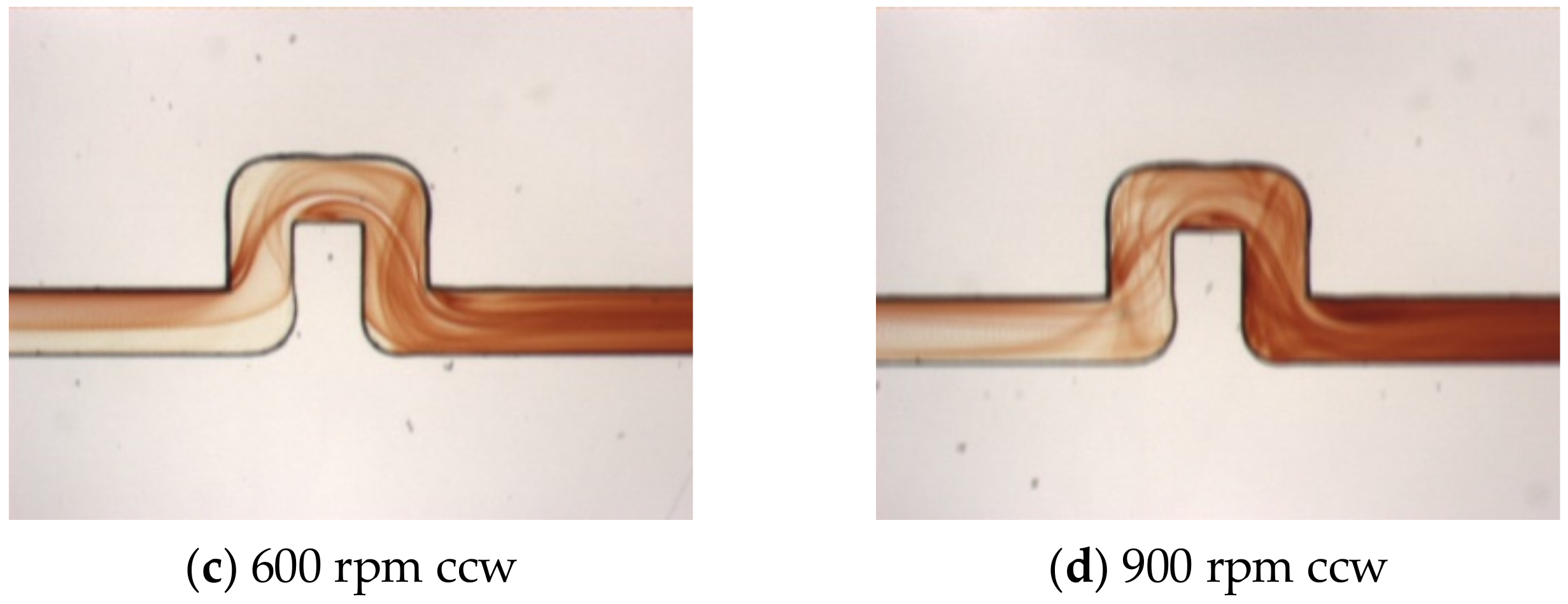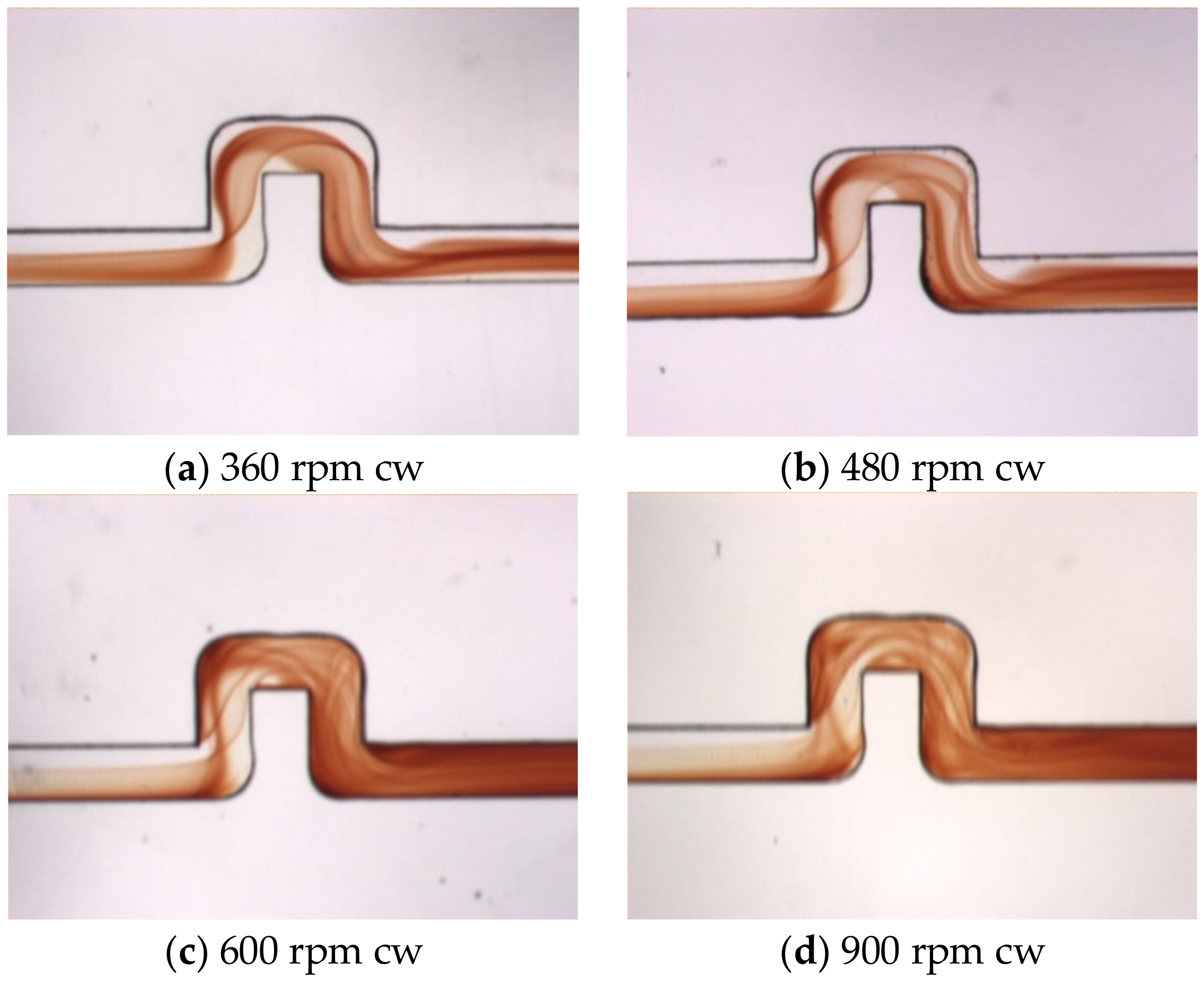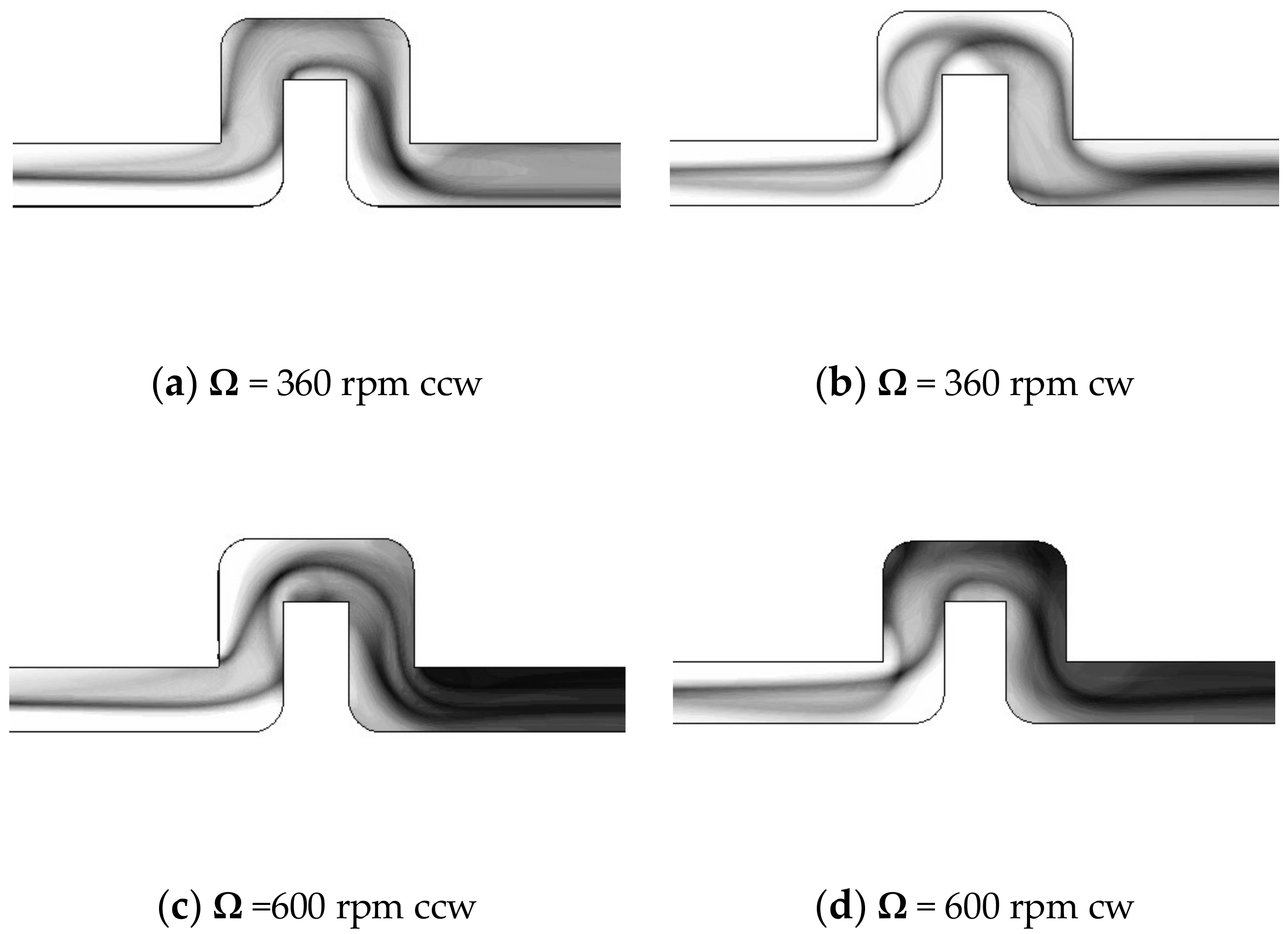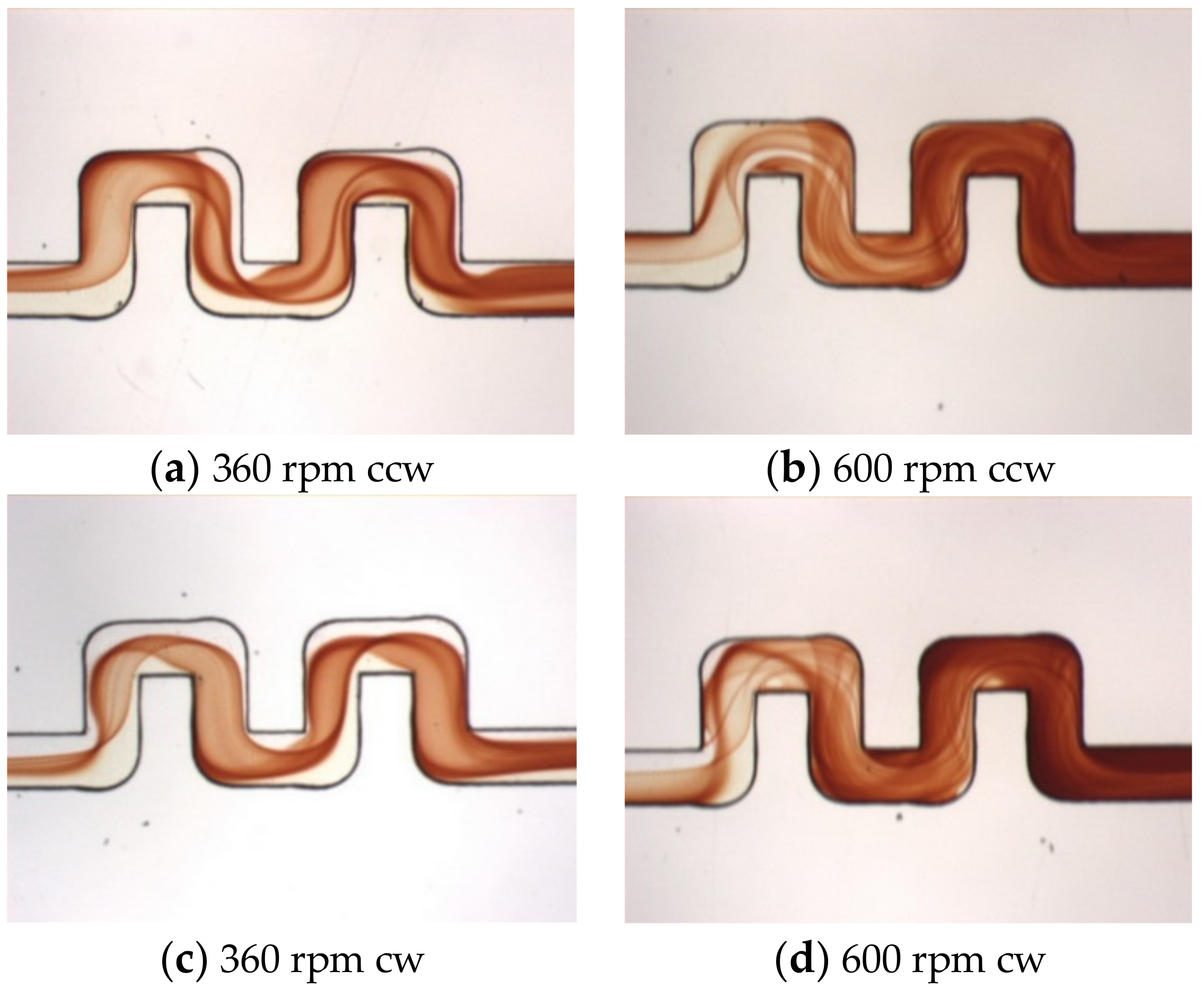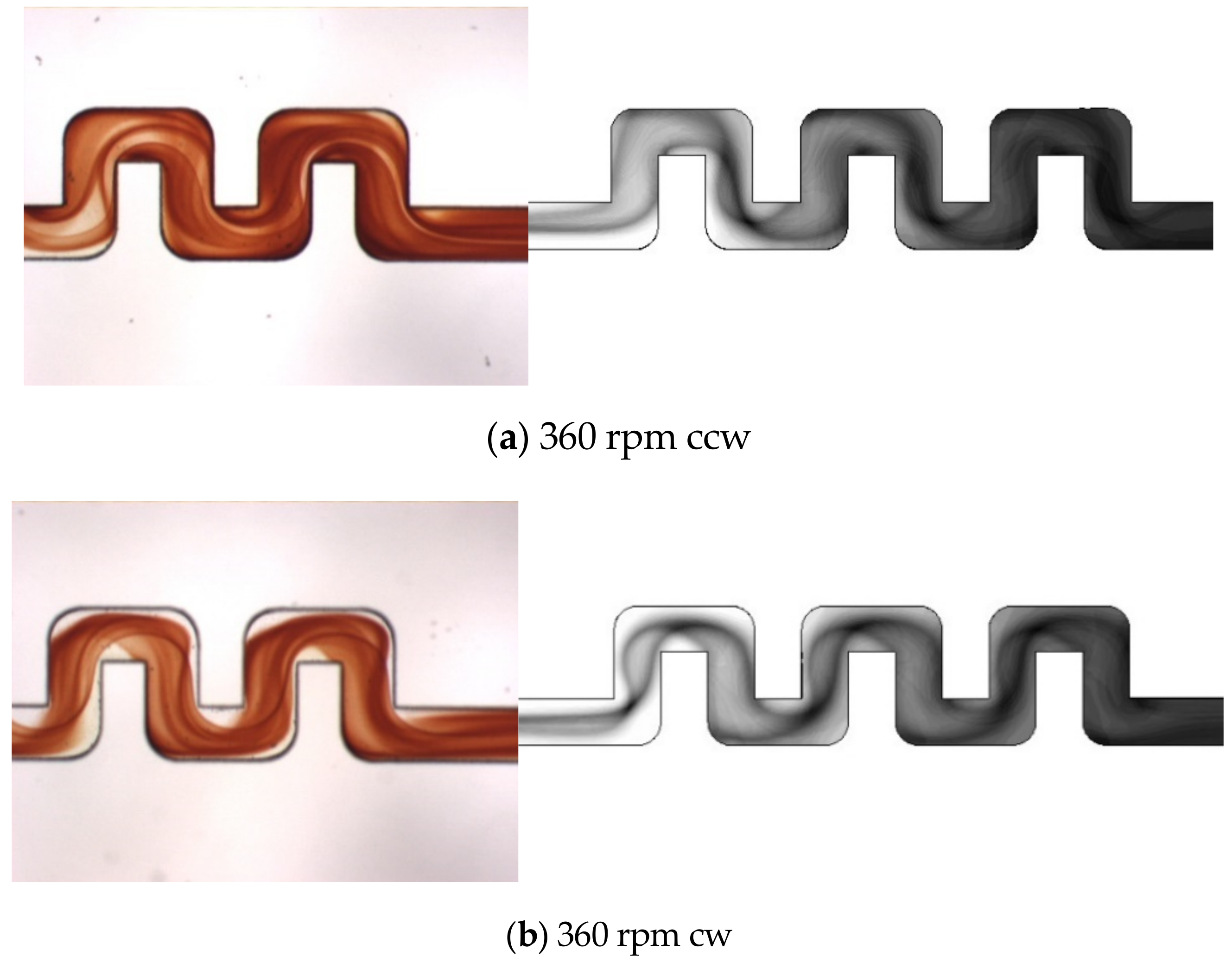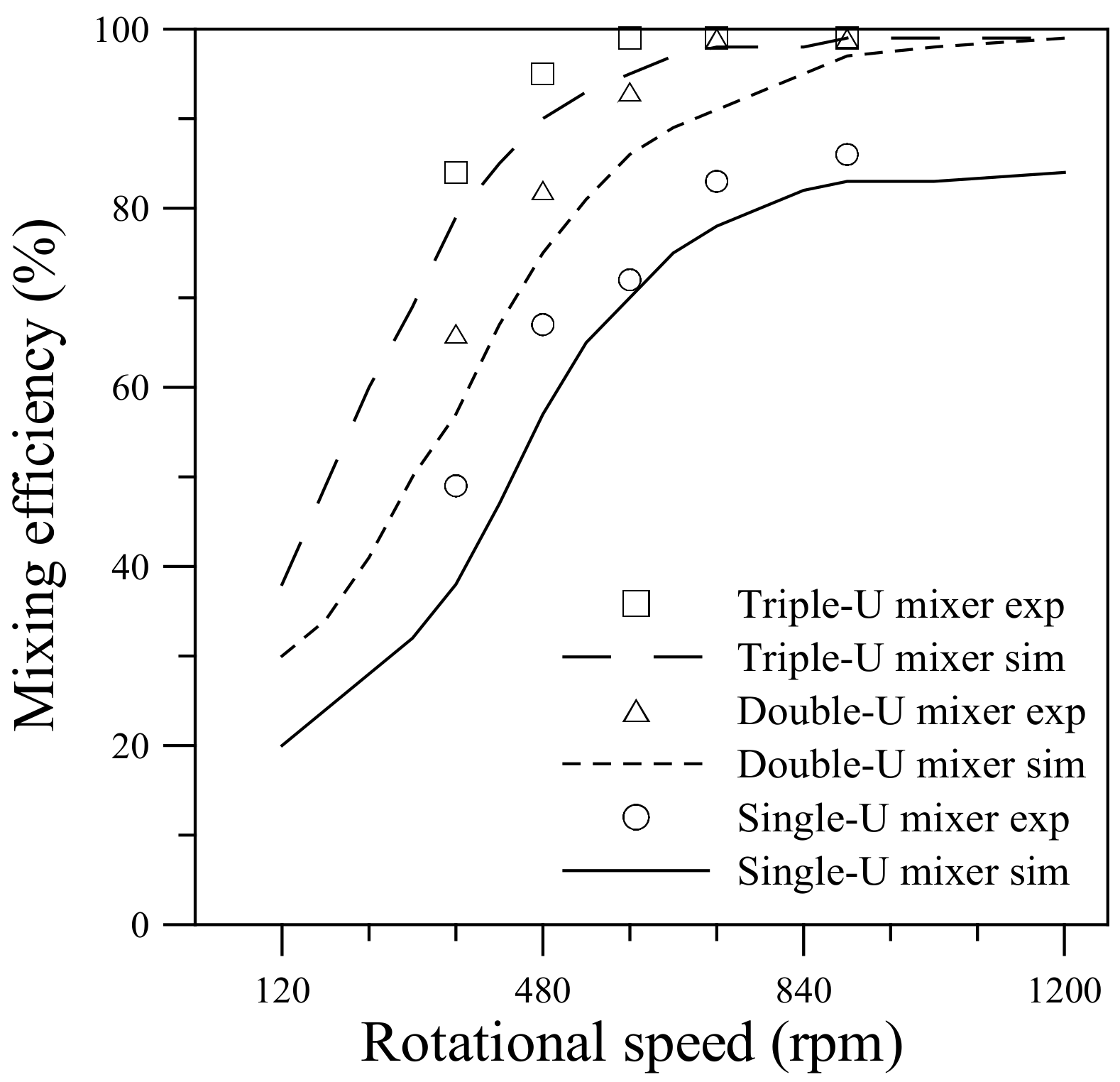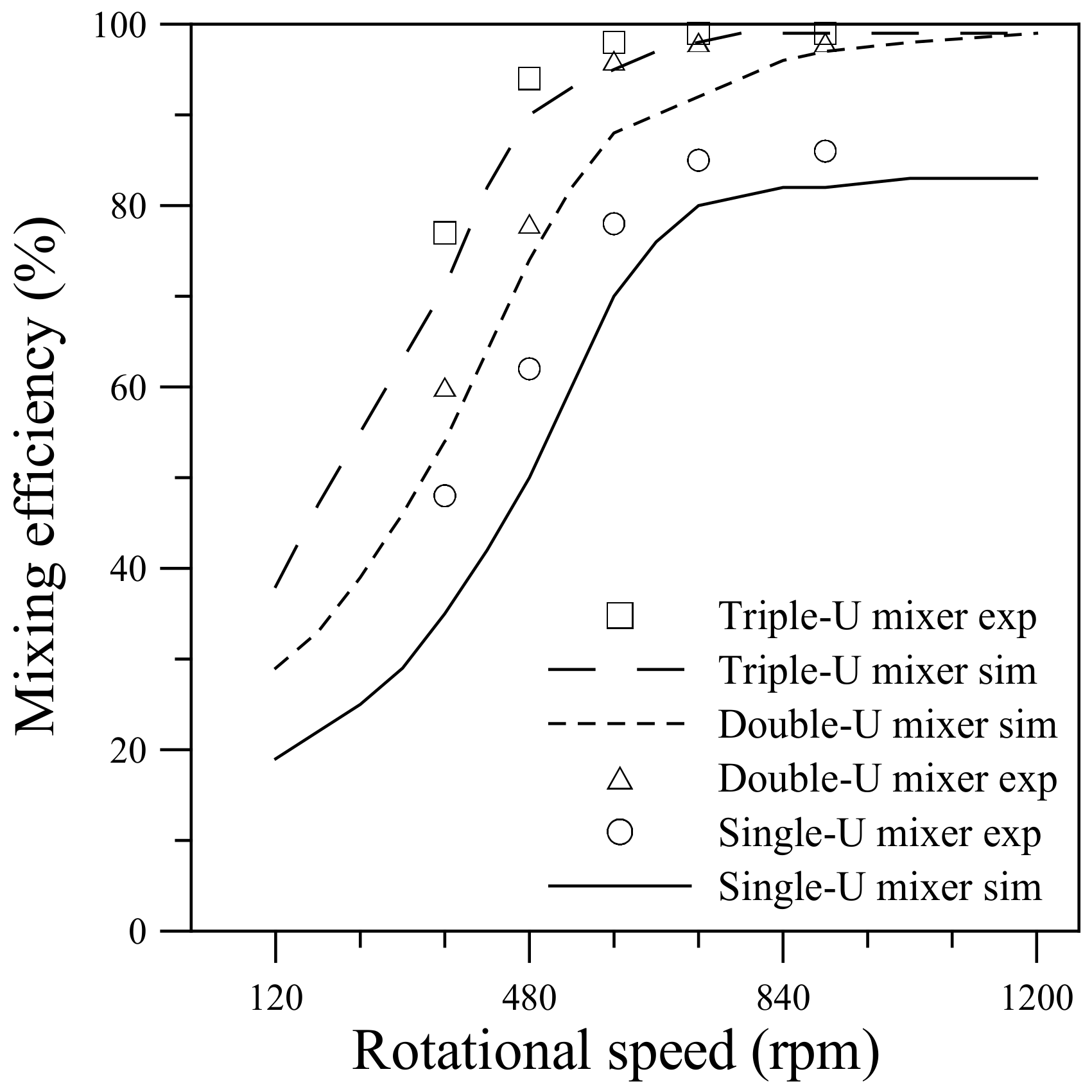4.1. Simulation Results
Figure 2 shows the top view of the single-U mixer with directions of the body forces and the simulation result of concentration for the mixer rotating at 600 rpm counterclockwise (ccw). The fluids in the rotating U-shaped channel can experience three types of body forces, namely the centrifugal force
fω generated through the system rotation, the Coriolis force
fC, and the Dean force
fD, which is the centrifugal force locally generated through the consecutive 90° bends [
36,
38]. The magnitude of these three forces may be estimated as follows [
42]:
where
r is the distance of the fluid to the center of rotation,
U is the stream velocity in the channel, and
R is the radius of the stream bended in the channel. The directions of Coriolis and Dean forces vary rapidly along the U-shaped channel as indicted in
Figure 2a, where the stream is driven by system’s centrifugal force under a counterclockwise rotation. Notably the Coriolis and Dean forces alternate not only in direction but also in position between Sections 2 and 4. The concentration distribution (with values between 0 and 1) at the midplanes is shown in
Figure 2b. At the inlets, red color represents fluid A of species concentration 1.0, and blue color fluid B of concentration 0. As the two fluids fully mix, the color turns green representing a concentration of 0.5. It can be seen that the Coriolis-induced transverse secondary flow begins to influence the interface in the straight channel region, moving fluid A toward upper and lower walls and fluid B toward sidewall A to form a “C-shaped” interface in Section 1 at
xc = 2.7 mm. Subsequently, the 90° bends appear to stir the fluids by flipping fluids A and B in Section 2. This can be seen first in Section 2 changing from AB to BA and flipping again in Section 3. Then in Section 4 where fluid A splits to sandwich fluid B forming ABA. In addition to flipping, interface folding also becomes more significant as the flow moves to Section 4. After flowing through these bends, the two fluids are well mixed in Section 5 (
xc = 4.2 mm). Similar patterns of flipping, splitting, folding and stirring were also observed in the study by La et al. [
35] but with a much longer circumferential channel length of 5.2 mm (17 times the channel width) at a much higher rotational speed Ω = 2000 rpm. It should be noted that there is no Dean force generated in a long circumferential channel (
R → ∞) [
38], in which the secondary flow is essentially induced by the Coriolis force.
Figure 3 and
Figure 4 show streamlines and velocity vectors, respectively, together with directions of the Coriolis and Dean forces on cross-sections 2–5 for the single U-mixer rotating at Ω = 360 and 600 rpm ccw. There are at least a pair of symmetric, counter-rotating vortices induced by the Coriolis and Dean forces on all the cross-sections for both two rotational speeds. At Ω = 360, these secondary vortices reverse their directions of rotation after the flow makes each of the 90° turns and then a saddle point can be found in Section 5. The reversed rotation of the secondary vortices after the 90° turns indicates effects of the Dean force, which as shown in
Figure 4a alternates its direction pointing from side walls B toward A (B→A) to A→B on Sections 3 and 4. In the meantime, the Coriolis force remains unchanged pointing from side walls B toward A (B→A) through the four 90° turns. At a higher rotational speed Ω = 600 rpm, one more pair of symmetric, counter-rotating vortices appear in Sections 3 and 5, indicating that the flow is significantly affected not only by the Coriolis force but also by the Dean forces in the transverse direction during the 90° turns. The significant effect of the Dean force can be seen in
Figure 4b displaying larger transverse velocities on Sections 3 and 4 as compared those at the lower rotational speed of Ω = 360 rpm. The strong transverse secondary flow initiated by the Coriolis force and then intensified by the Dean force through the 90° bends markedly enhances the fluid mixing as shown in
Figure 2.
The coupled Coriolis–Dean effects may be examined from the ratio
γc of the two forces given in Equations (6) and (7) as [
42]:
where the stream velocity
U is a function of rotational speed Ω. Then
U can be taken to be the mean velocity
Um and expressed as:
with
k representing the power-relation exponent. For a straight and round channel (
R → ∞) on a rotating disc, the power-relation exponent
k = 2 approximately [
26]. For the single-U mixer employed in the present study,
k ≈ 1.84 in the lower rotational speed range (Ω ≤ 480 rpm) and the exponent becomes smaller
k ≈ 1.41 in the higher range (Ω ≥ 600 rpm). Taking the case of Ω = 600 rpm as an example, with
Um = 0.38 m/s and an average radius
R ≈ (2
1/2)
b = 424 µm, the ratio of the Dean force to the Coriolis force is approximated to be
γc ≈ 7.1. This means that the Dean force dominates the Coriolis force in generating the secondary flow as the stream turns along the consecutive 90° bends, and the Dean–Coriolis force ratio increases with increasing rotational speed.
In addition, it is worth looking into the effect of the system’s centrifugal force on secondary flows, which play a major role in enhancing mixing of the present study, as compared to those of the Coriolis force and the Dean force. For a radial straight microchannel of rectangular cross-section, the ratio of the system’s centrifugal force to the Coriolis force may be scaled as [
30,
34]:
where the mean stream velocity
Um instead of the maximum stream velocity
Umax is used to scale the Coriolis force and a characteristic scaling
fC ∝ Ω
2 is invoked. As already mentioned, the mean stream velocity
Um depends on Ω, and the exponent
k in Equation (9) tends to decrease in the higher rotational speed range for the single-U mixer. It should be noted that in Equation (10), the Coriolis force is perpendicular to the radial direction of the system’s centrifugal force. The transverse secondary flow accompanied by the streamwise vorticity in the radial straight channel is mainly due to the Coriolis force, while the system’s centrifugal force contributes to drive the stream flow along the channel [
43,
44]. When examining the effect of the system’s centrifugal force on secondary flows in the circumferential channel section (orthogonal to the radial direction), great care is required because
fω is parallel to
fC. This effect may be understood based on vorticity consideration by rewriting Equation (2) for a constant angular velocity Ω as [
43,
44]:
where the centrifugal force is incorporated into the modified pressure
p* given by
The vorticity equation for incompressible flow can then be obtained by taking the curl of Equation (11) as [
45,
46]:
where
is the vorticity and ν is the kinematic viscosity. The three source terms on the right-hand side of Equation (13) represent the vortex stretching, the viscous diffusion of vorticity and the Coriolis-force production of vorticity, respectively. Note that the modified pressure does not appear in the vorticity equation since the curl of the gradient of any scalar is zero. This indicates that the system’s centrifugal force does not ‘directly’ contribute to generation of vorticity in the interior of the channel [
46,
47]. However, this does not mean that the system’s centrifugal force plays no role in generation of streamwise vorticity in a channel section that is orthogonal to the radial direction. The system’s centrifugal force, nevertheless, has important influences in helping vorticity generation in microchannel flow through change of the boundary geometry (e.g., a sudden expansion or a curved bend) and variation in pressure gradient along the channel’s solid surface [
47]. For the flow in the U-shaped channel structure with a very short circumferential section, the streamwise vorticities that lead to producing and intensifying the transverse secondary flow are generated mainly from stretching and turning of vortex lines through the consecutive 90° bends of the channel as well as from the Coriolis force. The streamwise vorticities generated when the flow turning along the consecutive bends are, in the present study, accounted for as the Dean–Coriolis force effect, which is indeed originated from the flow driven by the system’s centrifugal force.
Effects of the coupled Dean–Coriolis forces can also be revealed through comparison of centrifugal mixing characteristics between the U-shaped mixer and a T-type mixer.
Figure 5a illustrates schematic of the centrifugal T-type micromixer employed for the present simulations. The T-type micromixer with fluid inlets located at 30 mm from the center of the disc is simply a straight channel having the same cross-section (
b =
h = 300 μm), radial length (exit at
xc = 20 mm) and junction position (
xj = 1.3 mm) as the U-mixer.
Figure 5b displays the cross-sectional concentration distributions and velocity vectors computed at
xc = 4.2, which is the same
x-position as Section 5 of the U-mixer, for two rotational speeds Ω = 360 ad 600 rpm (ccw). A C-shaped interface of the fluids can be clearly seen in the cross-section for both rotational speeds. In the T-mixer, the transverse secondary flow is induced essentially by the Coriolis force alone [
30] since there is no Dean force in the straight channel (
R → ∞). It can be seen from the transverse velocity vectors that the secondary flow drives the fluids from side walls B toward A (B→A) in the middle of the cross-section neighboring
z = 0, where the maximum radial velocity occurs, and A→B near the top and bottom walls. When comparing these two cross-sectional distributions, the C-shaped interface for the higher rotational speed of 600 rpm appears to be a bit wider and lighter near the corners on side wall B than that of 360 rpm. This indicates a slightly better mixing for the higher rotational speed due to a stronger Coriolis-induced secondary flow that compensates for the shorter residence time of the mixing fluid stream.
Figure 6 compares mixing efficiency of the single U-shaped mixer with the T-type mixer at different rotational speeds ranging from 120 to 1200 rpm (ccw). The mixing efficiency was calculated using Equation (4) based on the cross-sectional concentration distribution in Section 5 (
xc = 4.2 mm) for the U-mixer and at the same
x-position (
xc = 4.2 mm) for the T-mixer. It can be seen that mixing efficiency for the U-mixer increases rapidly with rotational speed, from 20% at Ω = 120 rpm to 82% at Ω = 840 rpm. Beyond Ω = 840 rpm, the mixing efficiency appears to level off around 83–84%. The flat level efficiency in the higher speed range is due mainly to the high flow velocity that increases rapidly with rotational speed. The mean velocities at the U-mixer exit were found to be 0.67 m/s for Ω = 900 rpm and 1.0 m/s for Ω = 1200 rpm, corresponding to Reynolds numbers
Re = 200 and 300. The rapidly increasing velocity reduces the fluid residence time and appears to offset the growing influence of transverse secondary flow. It is worth mentioning that the simulations with different diffusion coefficients (1.0 × 10
-12 and 3.0 × 10
-9 m
2/s) also exhibit a similar trend of mixing efficiency variation with rotational speed as in
Figure 6 for the same U-shaped mixer, but give a slightly higher efficiency (by an amount of 5–6%) for the larger diffusion coefficient and slightly lower efficiency (by an amount of 4–5%) for the smaller diffusion coefficient in the level-off range Ω = 900–1200 rpm. In other words, changes in mixing efficiency contributed from the diffusion coefficient variation by an order of magnitude are limited. This indicates that advection plays the key role in enhancing fluid mixing for the present centrifugal U-shaped microchannel.
In
Figure 6, the T-mixer also shows an overall growth in mixing efficiency with increasing rotational speed due mainly to the Coriolis-induced secondary flow. However, the fluids flowing through the straight channel of the T-mixer without U-turns have a much lower mixing efficiency (8–20%) than that observed in the U-mixer. The comparison in
Figure 6 points out that Coriolis-induced vortices alone may not help mixing the fluids so much in a rotating microchannel. It is necessary to have the Dean flow generated during rapid turns of fluid stream along the consecutive bends to strengthen the transverse secondary flow for further enhancement of the mixing. The simulation results also indicate that the centrifugal U-mixer that enables effective assistance of fluid mixing within a short channel length is very suitable for use in CD-based microfluidic systems. Moreover, an additional U-shaped structure can be expected to further enhance the fluid mixing by maintaining a large value of
γc for a longer channel length.
4.2. Experimental Results and Comparison
Figure 7 shows flow visualization of top view images for the single-U mixer rotating at different speeds from 360 to 900 rpm (ccw). The flow enters the U-shaped channel from the left. At a lower speed of 360 rpm, the colored fluid appears on the upper side of the entrance region due to the effect of Coriolis force. The colored area indicates the mixed interface where the two testing fluids contact and react. The Coriolis force, in this counterclockwise rotating case, points downward on the top view images. As a result, the colored area in the entrance region appears in the upper half of the image, reflecting the C-shaped interface observed on Section 1 of
Figure 2c. The mixed area becomes wider but lighter, signifying stretching of the interface, as flow turns along the first and second 90° bends. Then along the third and fourth bends, the mixed interface clearly shows a twisting shape accompanied by the stretching phenomenon. At the exit of the U-shaped structure, the mixed area increases largely than at the entrance. As the speed increases to 480 rpm, the mixed area is enlarged in the entrance region where stretching and twisting of the interface take place slightly earlier than at the lower speed. Arriving at the fourth 90° bend, the colored lines’ entanglement implies folding and twisting of the interface. Thereafter the testing fluids mix well at the exit of the U-shaped structure. As the speed further increases to 600 and 900 rpm, folding and twisting of the interface occurs even earlier. As a result, the colored area covers nearly the whole downstream of the U-structure. It can be seen that the mixing performance is significantly enhanced at the exit for Ω = 900 rpm. Note that, at the higher speeds, the colored area appears to spread from the upper wall toward the down side but with lighter color. This is a result of large ratio of Dean–Coriolis forces that tends to widen the interface but the faster flow velocity, particularly in the neighborhood of the channel centerline, allows less time for the fluid interface to diffuse.
Under the effects of the Coriolis force, the present U-shaped mixer is not fully symmetric between the clockwise and counterclockwise rotations.
Figure 8 shows flow visualization of top view images for the same U-mixer of
Figure 7 but rotating clockwise (cw) at speeds from 360 to 900 rpm. The Coriolis force now points upward on the top view images for the flow in the
x-direction. Therefore the colored interface develops on the lower side of the image in the entrance region and becomes wider but lighter as the rotational speed increases. At lower speeds Ω = 360 and 480 rpm, it is observed that the interface turns around the second and third 90° bends without touching the upper wall of the radial channel between Sections 2 and 4 because of the upward Coriolis force, unlike those shown in
Figure 7a,b for the counterclockwise rotation. At higher speeds Ω = 600 and 900 rpm, the interface broadens and covers most of the channel after Section 2 due mainly to the stronger Dean force produced as the stream with a higher velocity turns along the 90° bends. It is also observed that at these higher velocities, stretching, folding and twisting of the fluid interface appear to display a lot more entangled lines and surfaces. As a result, the mixing at the exit becomes much better than at the lower speeds.
Figure 9 shows the top view images of numerical simulations displaying the fluid mixing phenomenon for Ω = 360 and 600 rpm undergoing both counterclockwise and clockwise rotations. Each of these simulation images are composed of the species concentration distributions on the
x-
y plane in the upper half of the channel (from
z = 0 to 150 μm). The concentration distributions are shown here in gray scale with black representing the complete mixing (
C = 0.5) and white for unmixed fluids (
C = 0 or 1.0). The composite distribution images were made for comparison with the visualization images of
Figure 7 and
Figure 8, which accumulated the entire color changes through the depth of the channel. For both lower and higher rotational speeds, the simulation images clearly demonstrate the interface shape that is affected by the Coriolis force and the Dean force as the stream turns along the 90° bends. The Coriolis effects caused by counterclockwise rotation can be distinct from those by clockwise rotation. For the higher rotational speed Ω = 600 rpm, the twisted and overlapped lines are largely increased to exhibit a darker surface, particularly near the exit of the U-shaped structure, indicating a higher mixing performance. The simulation images of
Figure 9 are consistent with and closely resemble those observed in the experiments having the same speeds and directions of rotation.
Figure 10 shows flow visualization of the double-U mixer at rotational speeds of 360 and 600 rpm. Both clockwise and counterclockwise rotations are presented for comparison. At the lower speed Ω = 360 rpm, with one more U-structure, it can be seen that the colored lines and surfaces representing the mixed fluid interface become more stretching and twisting in the second U-structure. For the higher speed Ω = 600 rpm, the colored lines and surfaces are largely entangled. For both lower and higher rotational speeds, the mixed area at the exit of the second U-shaped structure becomes darker than that observed in the single U-shaped structure. The second U-structure apparently further enhances the mixing through the intensified transverse secondary flow caused by the Coriolis force and the Dean force in particular during the four more 90° turns. In the clockwise rotation cases, the Coriolis force that points upward causes the mixed interface to move toward the lower half of the entrance channel. The stretching, twisting and folding phenomenon of the interface appears to be similar to that in the clockwise single-U mixer but larger in strength. The mixed area at the exit of the second U-structure for the higher rotational speed Ω = 600 rpm is observed to be darker than that for the single U-shaped channel.
Figure 11 presents the simulation results for the variations of mixing efficiency with the downstream channel distance beginning from the T-junction for the double-U mixer at Ω = 360, 600 and 900 rpm (ccw). At the lower speed Ω = 360 rpm, the mixing efficiency increases significantly at Sections 2–4 of the first U-structure and is further enhanced in at Sections 2–4 of the second U-structure. There is a small decline between Sections 4 and 5 of the second U-structure, which may be due to the fact that the rapidly changing flow directions are not perpendicular to the cross-sections during the turns, causing the concentration collected on the cross-section to have a small variation with the flow angle. At the higher speeds Ω = 600 and 900 rpm, the mixing efficiency dramatically grows at Sections 2–5 of the first U-structure. Then the efficiency still maintains a significant growth but with a less steep slope in the second U-structure. The dramatic growth followed by a significant rise in mixing efficiency is due largely to the strong Dean flow caused by the high Dean-Coriolis-force ratio (
γc ≈ 6.2 and 7.4 for Ω = 600 and 900, respectively).
Figure 12 shows top-view mixing images of flow visualization and numerical simulations of the triple-U mixer at a rotational speed of 360 rpm for counterclockwise and clockwise rotations. For the flow visualization images, only flow in the second and third U-structures are displayed because the visualization was designated to target the exit of the third U-structure for quantifying mixing efficiency. It can be observed that colored surfaces of the mixed-fluid interface in the second and third U-structures are even more stretching and twisting than those in double-U mixer at the same speed, indicating more stirring. It can also be seen from the visualization images that the counterclockwise rotation mixing appears to better the clockwise case. This could be due to the combined effects of Dean and Coriolis forces, which are toward more opposite directions between Sections 2 and 4 for the counterclockwise case, resulting in larger stirring of the mixing fluids than the clockwise case. The simulation images, displaying the flow along the whole three U-structures, clearly demonstrate the difference in interface shape between the counterclockwise and clockwise rotation cases as those shown in the flow visualization. The twisted and overlapped interface representing the mixed fluids become more entangled and darker in the second and third U-structures, indicating that mixing enhancement can be achieved with more U-structures.
Figure 13 compares the mixing efficiencies measured from the visualization experiments with those obtained from the numerical simulations for the single-, double- and triple-U mixers undergoing counterclockwise rotation at different speeds. A similar comparison for the three mixers undergoing clockwise rotation is presented in
Figure 14. Quantification of the mixing performance in the present experiments is based on the concentrations measured in the imaged area located at the exit of the U-shaped structure. The imaged area was approximately 450 μm × 400 μm with its left side located at
xc = 4.2, 5.4 and 6.6 mm for the single-, double- and triple-U mixer, respectively. The mixing efficiency computed from the pixel intensity of averaged RGB values in the imaged area is given by [
16]:
The maximum red intensity
Imax is observed in a fully mixed image and the minimum intensity
Imin is observed in an image of DI water. The technique of quantifying mixing efficiency from concentration measurements was employed previously by Chen et al. [
48]. For all the three U-mixers, the mixing efficiency measured from the visualization experiments increases sharply with increasing rotational speed in the lower range, Ω = 360 to 600 rpm for the single- and double-U mixers and an even lower range of Ω = 360 to 480 rpm for the triple-U mixer. As the speed further increases to 720 and 900 rpm, the efficiency gradually levels off for the single-U mixer. Nearly complete mixing is attained at Ω = 720 rpm for the double-U mixer and at an even lower speed of Ω = 600 rpm for the triple-U mixer. This increasing trend is observed in both counterclockwise and clockwise cases and is well predicted by the simulations with a constant diffusion coefficient of 3 × 10
−10 m
2/s.
For the single-U mixer undergoing counterclockwise rotation, the measured mixing efficiency increases from 48% at Ω = 360 rpm to 72% at Ω = 600 rpm and reaches 86% at Ω = 900 rpm. The clockwise rotation case is slightly lower than the counterclockwise rotation by about 5% at Ω = 480 rpm. But at Ω = 600 rpm, the clockwise rotation jumps to lead the counterclockwise rotation by approximately 6% and then approaches a maximum of 86% as the speed further increases. For the double-U mixer, the measured mixing efficiency is apparently higher than that for the single-U mixer by an amount of 10–20%. The efficiency increases from 60–65% at Ω = 360 rpm to reach nearly 99% at Ω = 720 and 900 rpm for both clockwise and counterclockwise cases. This is consistent with the observation of
Figure 10. An additional U-shaped structure further enhances the mixing through the intensified transverse secondary flow caused by the Coriolis and Dean forces with four more 90° turns of the stream. In the meantime, the mean velocity at the exit of the double-U mixer is found to be slower than that of the single-U mixer by 13–17%, which leads to an increase of fluid residence time giving help to the mixing. The mean velocity was estimated from the visualization images beginning from the burst of flow until the fluid reservoirs become empty. It was found that the mean velocity reduced from 0.16 m/s for the single-U mixer to 0.14 m/s for the double-U mixer at the burst rotational speed Ω = 360 rpm, and from 0.74 to 0.64 m/s at the highest speed Ω = 900 rpm. For the triple-U mixer under counterclockwise rotation, the measured mixing efficiency was found to be higher than 80% even at a lower speed Ω = 360 rpm, subsequently grows to 95% at Ω = 480 rpm and then reaches a nearly complete mixing value of 99% at Ω = 600 rpm and beyond. In the clockwise rotation case, efficiency for the triple-U mixer also significantly better than those for single- and double-U mixers, attaining about 95% at Ω = 480 and 600 rpm, and rising to near complete mixing at Ω = 720 and 900 rpm. For a lower speed of 360 rpm, the efficiency appears to be 7% lower than that of counterclockwise rotation at the same speed, as observed in
Figure 12. The simulations that cover a rotational range of 120–1200 rpm show in good agreement with measurements. Overall, the simulation efficiencies appear slightly lower than the measured values with an average difference of about 4%. At Ω = 900, the simulation mixing efficiency approaches 97% for the double-U mixer and 99% for the triple-U mixer. With one or two more U-structures, the simulation mean velocity was also found to be slower becoming 0.59 and 0.53 m/s at Ω = 900 rpm for the double- and triple-U mixers, respectively. Moreover, the simulations show no discernible difference in mixing efficiency between clockwise and counterclockwise cases, for which the difference in mean velocity is very small (~1%) at the same rotational speed.

